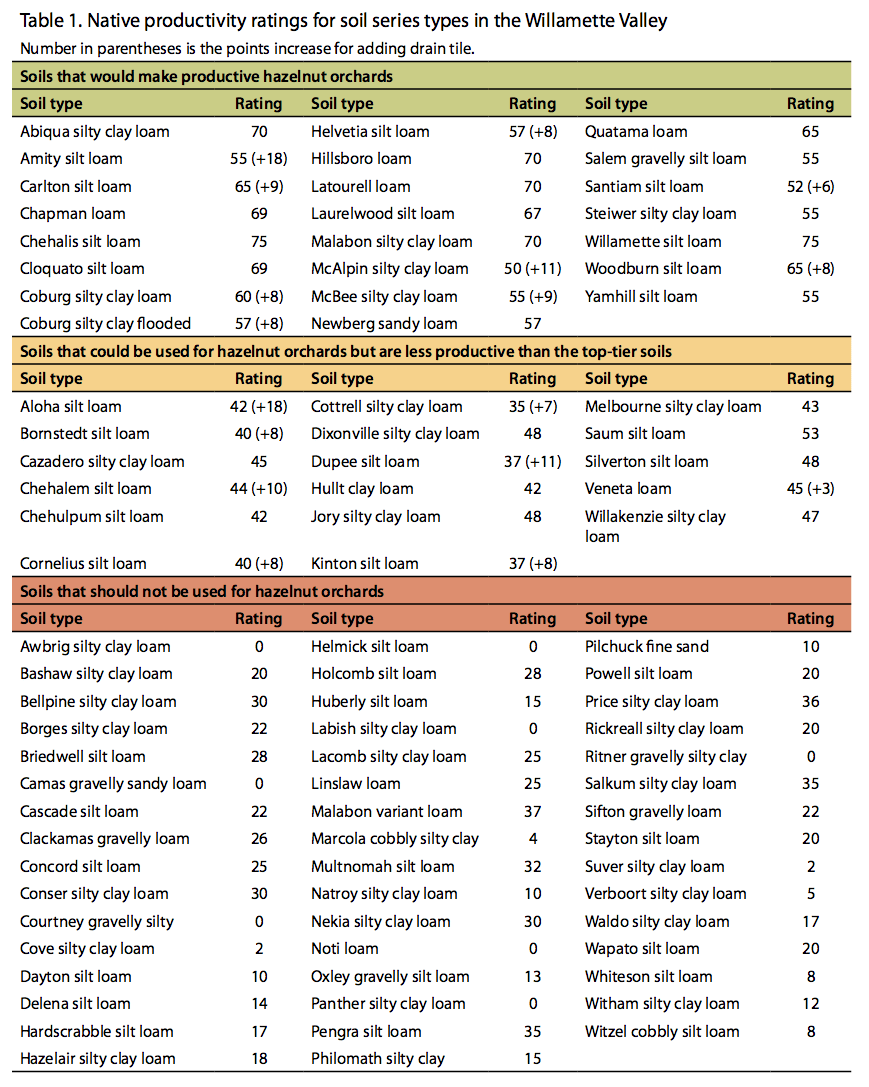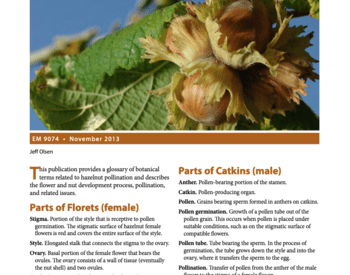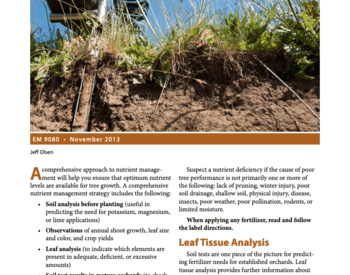Location
Soil series type is a major factor to consider when deciding where to plant a hazelnut orchard. Trees grown on deep, medium-textured bottomland are larger and more productive than trees grown on soils that are shallow, sandy, or high in clay content. Hazelnut trees do not tolerate wet soils during the active growing season. However, their roots are shallower than those of most fruit trees. Because waterlogged soils dry out from the top down, the rooting zone of hazelnuts dries faster than that of deeper-rooted trees.
Air drainage also is important. Because cold air sinks, late-April frosts in low-lying areas frequently damage cluster buds and succulent green shoots. Few hazelnut orchards have been planted on sites above 1,500 feet (about 460 meters) in elevation. Therefore, it is difficult to evaluate the commercial worth of these sites.
When an orchard is located on a slight slope, the direction the slope faces does not affect air drainage. However, the slope does affect soil depth and moisture retention. Hazelnut orchards on steep slopes often produce less than those on more level ground, even with the same soil series types. Tops of hillsides often suffer from erosion, which reduces the soil rooting depth. And harvest is often more difficult on a steeper slope.
Orchard sites should be suitable for long-term production. Avoid sites that are likely to be claimed for subdivisions, freeways, or industrial property in the foreseeable future.
Suitable Soils
Do not locate a hazelnut orchard where the soil is poorly drained, shallow, too heavy, or too light. An orchard that is unproductive because of unsuitable soil is not profitable.
Although most of a hazelnut tree’s roots are found in the first 2 feet (0.6 meters) of soil, suitable soils allow trees to develop active root systems to depths of 6–10 feet (1.8–3 meters). Soils that are shallow or rocky, have an impermeable layer or hardpan, have a high water table, or lack aeration inhibit root penetration and growth. Trees might grow on these soils for the first 8–10 years, but then they will become poor producers because of the limited root growth.
Hazelnut trees draw moisture from the upper soil layers more rapidly than from lower depths. The top 2 feet (0.6 meters) of soil might be dry by the end of June, but the next 2 feet (0.6 meters) might contain moisture until August. Trees with shallow root systems cannot reach this deep reservoir of moisture. Irrigation might ease this problem, but it involves considerable expense. Furthermore, shallow soils often are poorly drained. In this case, irrigation only makes the problem worse. Soil that is too sandy might not hold enough water for good hazelnut growth.
Tile drainage of wet land has been attempted with varying degrees of success depending on the soil series type. On land that needs drainage, the subsoil layer that supports the water is often so close to the surface that very little suitable soil remains above it. If the subsoil is so compact and dense that water will not pass through, tree roots will not penetrate it to grow normally. Tiling such soils might increase the area available for root activity early in the year by draining the upper layer of soil, but this still does not provide the best growing conditions because the subsoil remains too compacted for good root growth.
Determining Soil Suitability
The soil types of western Oregon have been classified and mapped. These maps give the soil series, texture, and sometimes the average depth for most potential orchard sites. Use the USDA Natural Resource Conservation Service soil surveys to search for land suitable for establishing hazelnut orchards in the Pacific Northwest. The NRCS has an office in each Oregon county. You can also use the Web Soil Survey tool: http://websoilsurvey.nrcs.usda.gov/app/HomePage.htm
Referring to soil maps is the first step in determining the suitability of a site for hazelnut production. However, although the map gives useful information, you probably will need to investigate further.
Performing some on-site work on the soils you are considering is often helpful. Dig several holes in multiple locations in the field with a posthole digger, soil auger, or shovel in March or April. Examine the soil to a depth of 4–6 feet (1.2–1.8 meters) to discover any variations in soil depth or drainage. Soil that has grayish, yellowish, or reddish mottling (colored spots or blotches) probably is poorly drained.
Check to see whether the holes fill with water overnight when there is no rainfall. Water in the holes indicates poorly drained soil or a high water table. Watch to see how long it takes for the water table to drop below the bottom of the holes. Hazelnut trees can withstand a fairly high water table in March if the water table drops in April and if water in the soil below 4 feet (1.2 meters) drains freely. The small feeder roots affected by the high water table will die, but when the water drains, new roots will grow and use the remaining moisture.
Oregon State University soil scientists developed agricultural productivity ratings in the early 1980s. Native productivity ratings are listed in Table 1. These ratings represent the soils series types just as they are, without drain tile or amendments. The ratings are calculated by evaluating the effects of various properties including texture, drainage, and depth of the series types for agricultural purposes. Good soils are deep, well-drained soils of medium texture. The better the soil, the higher the native productivity rating. The rating scale goes from 0 to 75. Willamette Silt Loam, one of the best soils in the Willamette Valley, has a rating of 75.
Some soils improve with drainage; others don’t. Some soils are simply too thick with clay to allow water to drain off with tile. Furthermore, starting out with a very poor soil and paying for drain tiling to make it slightly better is seldom worth the investment. Any soil with a rating of at least 50 is worth draining if the improvement is 8–9 points. For example, Amity has a rating of 55 and improves 18 points with drain tile.
Amendments such as lime and fertilizer can improve the fertility of any soil. However, it is impractical to change the soil texture throughout the entire rooting depth in a hazelnut orchard. Shallow-rooted crops like vegetables and some berries are more amenable to improving the soil texture by adding organic matter and working it into the top 1–2 feet of soil.
Many soils used for agricultural purposes can benefit from irrigation. On good soils, irrigation can improve productivity, but the economic benefit of the investment depends on the value of the specific crop. On poorly drained soils, the economic benefits do not outweigh the investment required to install an irrigation system.
For More Information
Many Oregon State University Extension publications on hazelnut production are available through the OSU Extension Catalog:
This information is provided for educational purposes only. If you need legal [or tax] advice, please consult a qualified legal [or tax] adviser.
Trade-name products and services are mentioned as illustrations only. This does not mean that the Oregon State University Extension Service either endorses these products and services or intends to discriminate against products and services not mentioned.
Use pesticides safely!
- Wear protective clothing and safety devices as recommended on the label. Bathe or shower after each use.
- Read the pesticide label—even if you’ve used the pesticide before. Follow closely the instructions on the label (and any other directions you have).
- Be cautious when you apply pesticides. Know your legal responsibility as a pesticide applicator. You may be liable for injury or damage resulting from pesticide use.
© 2017 Oregon State University.
Extension work is a cooperative program of Oregon State University, the U.S. Department of Agriculture, and Oregon counties. Oregon State University Extension Service offers educational programs, activities, and materials without discrimination on the basis of race, color, national origin, religion, sex, gender identity (including gender expression), sexual orientation, disability, age, marital status, familial/parental status, income derived from a public assistance program, political beliefs, genetic information, veteran’s status, reprisal or retaliation for prior civil rights activity. (Not all prohibited bases apply to all programs.) Oregon State University Extension Service is an AA/EOE/Veterans/Disabled.





